11 December 1993 (1993-12-11) 1997 → 22 seats 22 seats 15 12 Date 11 December 1993 | 11 May 1992 4 September 1992 37 seats 10 seats 61.0% 39.0% Winner Dean Brown | |
 | ||
State elections were held in South Australia on 11 December 1993. All 47 seats in the South Australian House of Assembly were up for election. The incumbent Australian Labor Party led by Premier of South Australia Lynn Arnold was defeated by the Liberal Party of Australia led by Leader of the Opposition Dean Brown. The Liberals won what is still the largest majority government in South Australian history.
Contents
Background
The campaign was dominated by the issue of the collapse of the State Bank of South Australia in 1992. The State Bank's deposits were legally underwritten by the Government of South Australia, putting South Australia into billions of dollars of debt. Labor premier John Bannon had resigned over the issue, being replaced by Lynn Arnold just over a year before the election. Following the leadership change and by early 1993, Newspoll had recorded a total rise of 13 percent in the Labor primary vote. However, the gains did not last. A warning sign of things to come came with the March 1993 federal election, which saw two of Labor's longest-held seats in South Australia, Hindmarsh and Grey, fall to the Liberals. Hindmarsh had been in Labor hands without interruption since 1919, while Grey had been in Labor hands for all but one term since 1943.
The Liberals under Dean Brown went into the election as unbackable favourites, and swept the 11-year Labor government from power in a massive landslide. They won 37 of 47 seats (78.7 percent of the available seats) in the South Australian House of Assembly from a 15-seat swing − in terms of seat count and percentage of seats won, the largest majority government in the state's history. The 15-seat swing is still the largest in South Australian state history. Adelaide, which had been Labor's power base in the state for decades, swung over dramatically to support the Liberals. Labor lost seats in several parts of Adelaide where it had not been seriously threatened in memory, and was cut down to only nine seats in the capital. The Liberals won 61 percent of the two-party vote, the largest two-party preferred vote in South Australian state history (dating back to the first statewide two-party calculations from 1944). Labor fell to just 39 percent of the two-party vote from a two-party swing of 9.1 percent—at the time, the largest two-party swing in South Australian state history, and still the largest that resulted in a change of government.
Still, the Liberals were left one short of a majority in the South Australian Legislative Council with the sole balance of power held unbroken by the Australian Democrats since their inception in the mid-1970s. Though the Democrats would exceed 16 percent of the vote in 1997, during the following term the Democrats would lose the sole balance of power for the first time, sharing the balance of power with Nick Xenophon and two ex-Labor independent members, slowly losing numbers and influence, until they were eventually without parliamentary representation as of the 2010 election.
The stratospheric records for seat count and percentage of seats in the House led to predictions of a generation of Liberal government. However, the Liberal gains were short lived. Brown's factional rival, John Olsen, successfully challenged Brown for the Liberal leadership in 1996. In turn, the Liberals were reduced to a minority government as a result of the 1997 election, following another record two-party swing in the other direction of 9.5 percent.
A 1994 Torrens by-election saw Labor take the seat from the Liberals. The 1994 Elizabeth by-election and 1994 Taylor by-election saw Labor retain both seats.
Legislative Council results
In the Legislative Council, Liberal won 6 seats, Labor 4, and the Australian Democrats 1. This left the total upper house numbers at Liberals 11, Labor 9, Democrats 2.
